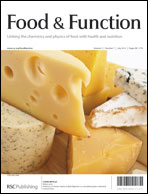This month sees the following articles in Food & Function that are in the top ten most accessed:-
Nuts, especially walnuts, have both antioxidant quantity and efficacy and exhibit significant potential health benefits
Joe A. Vinson and Yuxing Cai
Food Funct., 2012, Advance Article, DOI: 10.1039/C2FO10152A
Effects of tea and coffee on cardiovascular disease risk
Siv K Bøhn, Natalie C Ward, Jonathan M Hodgson and Kevin D Croft
Food Funct., 2012, Advance Article, DOI: 10.1039/C2FO10288A
The interactions between endogenous bacteria, dietary components and the mucus layer of the large bowel
Alicia M. Barnett, Nicole C. Roy, Warren C. McNabb and Adrian L. Cookson
Food Funct., 2012, Advance Article, DOI: 10.1039/C2FO30017F, Review Article
Target molecules of food phytochemicals: Food science bound for the next dimension
Akira Murakami and Kohta Ohnishi
Food Funct., 2012,3, 462-476, DOI: 10.1039/C2FO10274A, Review Article
Review of in vitro digestion models for rapid screening of emulsion-based systems
David Julian McClements and Yan Li
Food Funct., 2010,1, 32-59, DOI: 10.1039/C0FO00111B, Review Article
Transcription profiles of LPS-stimulated THP-1 monocytes and macrophages: a tool to study inflammation modulating effects of food-derived compounds
Wasaporn Chanput, Jurriaan Mes, Robert A. M. Vreeburg, Huub F. J. Savelkoul and Harry J. Wichers
Food Funct., 2010,1, 254-261, DOI: 10.1039/C0FO00113A
Espresso coffees, caffeine and chlorogenic acid intake: potential health implications
Thomas W. M. Crozier, Angelique Stalmach, Michael E. J. Lean and Alan Crozier
Food Funct., 2012, 3, 30-33, DOI: 10.1039/C1FO10240K
Coffee melanoidins: structures, mechanisms of formation and potential health impacts
Ana S. P. Moreira, Fernando M. Nunes, M. Rosário Domingues and Manuel A. Coimbra
Food Funct., 2012, Advance Article, DOI: 10.1039/C2FO30048F, Review Article
Whole grain cereals: functional components and health benefits
Rafael Borneo and Alberto Edel León
Food Funct., 2012,3, 110-119, DOI: 10.1039/C1FO10165J, Review Article
Recent developments on polyphenol-protein interactions: effects on tea and coffee taste, antioxidant properties and the digestive system
Prasun Bandyopadhyay, Amit K. Ghosh and Chandrasekhar Ghosh
Food Funct., 2012, Advance Article, DOI: 10.1039/C2FO00006G
Why not take a look at the articles today and blog your thoughts and comments below.
Fancy submitting an article to Food & Function? Then why not submit to us today or alternatively email us your suggestions.
 Food & Function issue 7 is now online; you can read it in full here. This issue contains an Editorial introducing the new editors in food structure and functionality. Tim Foster (Nottingham University, UK) joins Steven Feng Chen and Cesar Fraga as Associate Editor and Nissim Garti joins the Editorial Board. Read the editorial here and read Nissim Garti’s Review on lyotropic liquid crystals (LLC) as delivery vehicles for cosmetoceuticals, nutraceuticals, and drugs, also contained in this issue, here.
Food & Function issue 7 is now online; you can read it in full here. This issue contains an Editorial introducing the new editors in food structure and functionality. Tim Foster (Nottingham University, UK) joins Steven Feng Chen and Cesar Fraga as Associate Editor and Nissim Garti joins the Editorial Board. Read the editorial here and read Nissim Garti’s Review on lyotropic liquid crystals (LLC) as delivery vehicles for cosmetoceuticals, nutraceuticals, and drugs, also contained in this issue, here.














